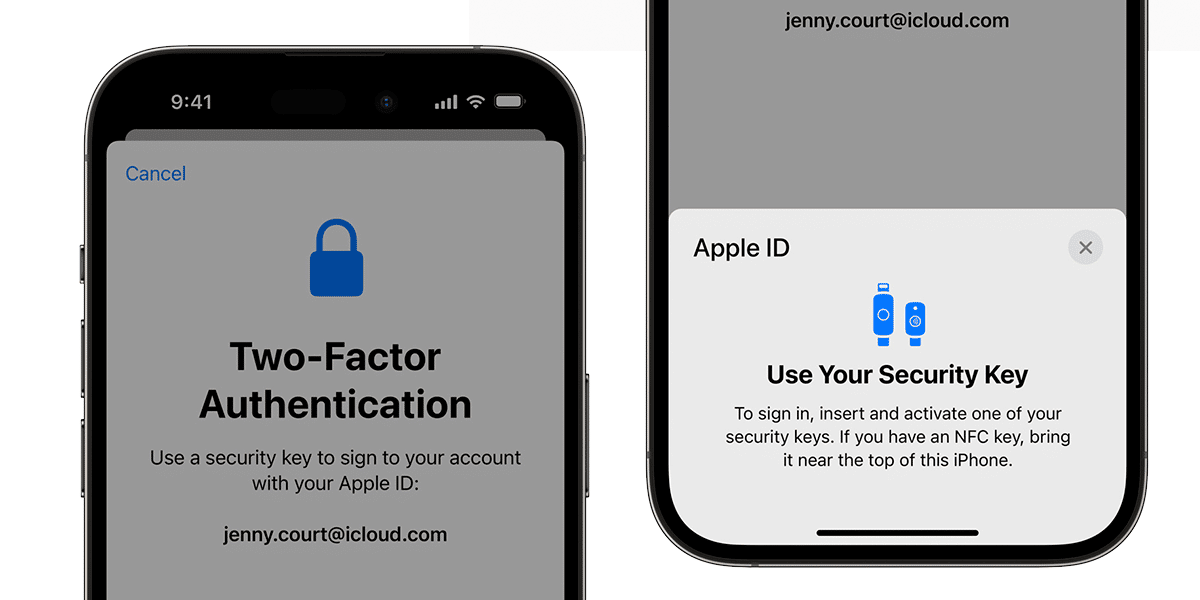
Apple's commitment to security continues from the first moment they proposed to focus on the user in their ecosystem. Since then, every time a new big update is released, they save a space to dedicate to the news related to the improvement of user privacy and security. Ago some weeks introduced the security keys for our Apple ID, a physical device that allows us to add an extra layer of security to our Apple account. If you want to know how these security keys work, what advantages it provides you and what you need to start using it, keep reading.

A Look at FIDO Alliance Security Keys
As we have commented, security keys They are a small physical external device that resembles a small USB flash drive. This device can be used for many functions and one of them is the verification when signing in with our Apple ID using two-factor authentication.
To make the compression easier let's say that when we use two-factor authentication to log in somewhere we do it through two steps. The first factor is access with our credentials, but then we need an external confirmation through a second factor. Normally it is usually a code that we receive in the form of a text message to our phone or confirm the session from a device with the account and started.
There is an evolution of this second factor known as U2F, Universal 2nd Factor, which improves the security and reliability of double authentication. For it additional hardware is necessary to be able to access an account, this hardware being the second factor to verify our account. And that hardware we are talking about is the security keys.

iOS 16.3 and security keys
iOS 16.3 introduced the compatibility of security keys to access our Apple ID when we start it somewhere we are not logged in. With these keys, what Apple wants to do is prevent identity fraud and social engineering scams.

Thanks to these security keys two-factor authentication improves slightly. Remember that the first data is still the password of our Apple ID but the second factor is now the security key and not the old code that was sent to another device in which our session was already started. With the simple fact of connecting the key we will be able to gain access by skipping this second step, because the second step is intrinsically the key itself.

What do we need to start making use of this improved two-step verification?
Apple clearly defines it on its support website. It is necessary to have of a series of requirements before you start using security keys indiscriminately. These are the requirements:
- At least two FIDO® Certified security keys that work with the Apple devices you use regularly.
- iOS 16.3, iPadOS 16.3, or macOS Ventura 13.2 or later on all devices where you're signed in with your Apple ID.
- Activating two-step authentication for your Apple ID.
- A modern web browser.
- To sign in to Apple Watch, Apple TV, or HomePod after setting up security keys, you need an iPhone or iPad with a software version that supports security keys.
In short, we need at least two security keys, all devices updated to iOS 16.3, and a modern web browser.

The limitations of the security key for our Apple ID
At first glance, this system seems to have many good things, especially not depending on a six-digit code every time we want to log in to our Apple ID account. However, like all tools, they have limitations that can make a difference when using or not the functionality.
Apple has highlighted the following within their website:
- You can't sign in to iCloud for Windows.
- You can't sign in to older devices that can't be upgraded to a software version compatible with security keys.
- Child accounts and Managed Apple IDs aren't supported.
- Apple Watch devices paired with a family member's iPhone aren't supported. To use security keys, first set up the watch with your own iPhone.
With these limitations Apple intends to focus on the user himself exclusively to protect his information. When we start introducing shared user accounts or Family accounts we slightly open our information to other people and that makes us vulnerable. The new standards incorporated in iOS 16.3 along with security keys They only work if we have an individualized Apple ID in us and closed to functions such as Family.
